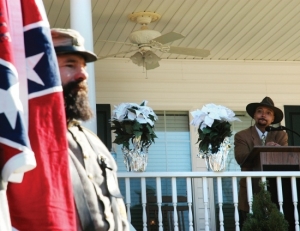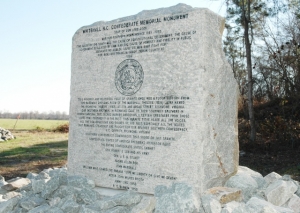Monument to Whitehall battle is dedicated in Seven Springs
By Dennis Hill
Published in News on December 14, 2008 2:00 AM

News-Argus/DENNIS HILL
Earl Ijames, right, curator of the North Carolina Museum of History, speaks on slavery at the dedication of monument to Confederate soldiers killed at the Battle of Whitehall in 1862. The monument was erected near Seven Springs by the Sons of Confederate Veterans.

News-Argus/DENNIS HILL
This granite monument honoring the Confederate soldiers killed at the Battle of Whitehall and the sailors who served aboard the CSS Neuse was dedicated at a ceremony Saturday. The monument, erected by the Sons of Confederate Veterans, is visible from Lynch Road near Seven Springs.
SEVEN SPRINGS -- A granite monument honoring the Confederate soldiers killed at the Battle of Whitehall in 1862 was dedicated Saturday on a piece of land less than a mile from the site of the original Civil War clash.
Members of the Sons of Confederate Veterans paid tribute to the fallen 13 soldiers during a ceremony off Lynch Road, on the north bank of the Neuse River, where Confederates held off Union attackers on a similarly chilly December day.
The monument also pays tribute to the men who served as sailors aboard the CSS Neuse gunboat that was under construction at Whitehall, now Seven Springs, at the time of the battle.
And it specifically honors eight Sutton brothers from the area who fought for the South, four of whom did not make it home.
The monument, made from a stone used as a floor support in the Marshall/Richmond Theater in Richmond, Va., was erected by the SCV on land donated by Dan and Wendy Boyette.
The organization is dedicated to keeping alive the memory of the men who fought for the South.
"Our ancestors are the roots of the greatness of this country," Tom Smith, the division commander of the SCV in North Carolina, told a gathering of about 150 attendees.
The featured speaker for the event was Earl Ijames, the curator for the North Carolina Museum of History.
Ijames described slavery in 19th century America, noting that modern history has created many myths about the institution.
Many blacks in the 1860s were free men, he said. And some blacks owned other blacks. Most slaves did not live on large plantations but were owned alone or in a pair by a small white farm family. Most whites did not own slaves, he said. Those who did usually worked alongside them.
Many black men served in the Confederate army, Ijames noted. The North would not accept blacks as soldiers at first, he said, and many blacks, both slave and free, saw joining the Southern army as a way to improve their status.
He cited Union officers' memoirs of running into black rebel soldiers in battle and being surprised.
"We need to present a more balanced history," he said, adding that the black Confederate soldier has been lost to history.
"They never got recognized, but we are starting to change that," Ijames said.
Ijames commended the work of the SCV, saying it is important that all of American history is preserved accurately.
The Sutton boys were the sons of Benjamin Sutton, who farmed in the Seven Springs vicinity in the 19th century. Eight of his sons went off to war. Only four returned. A ninth son was deemed too young for the army and served in the home guard instead.
The Neuse survived the battle and was eventually put into service but was scuttled near Kinston, where its remains are maintained at a state park. A copy of the boat was built a few years ago and is on display on Heritage Street in Kinston.
